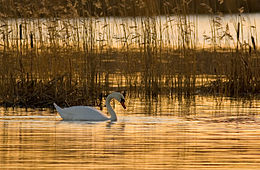Hydrosere

A hydrosere is a
The succession from open water to climax woodland takes centuries or millennia. Some intermediate stages will last a shorter time than others. For example, swamp may change to marsh within a decade or less. How long it takes will depend largely on the amount of siltation occurring in the area of open water.
Stages
Hydrosere is the primary succession sequence which develops in aquatic environments such as lakes and ponds. It results in conversion of water body and its community into a land community. The early changes are
If water body is large and very deep, a strong wave action is at work, therefore in these bodies a noticeable change cannot easily be observed. However, in smaller water body such as a pond the succession is easily recognizable. Different plant communities occupy different zones in a water body and exhibit concentric zonation. The edges of the water body are occupied by rooted species, submerged species are found in the littoral zone and plankton and floating species occupy the open water zone.[1]
There is nevertheless still debate about whether dry woodland is always the final climax community, or whether a watery, bog community can also be the final, stable, climax community.[2]
Phytoplankton stage
Phytoplanktons (cyanobacteria), green algae (Spirogyra, Oedogonium), diatoms, etc. are the pioneer colonizers in the initial stage, starting from a water body, such as a pond. Their spores are carried by air to the pond. The phytoplankton are followed by zooplankton. They settle down to the bottom of the pond after death, and decay into humus that mixes with silt and clay particles brought into the basin by run off water and wave action and form soil. As soil builds up, the pond becomes shallower and further environmental changes follow.[1]
Submerged stage
As the water body becomes shallower, more submerged rooted species are able to become established due to increasing light penetration in the shallower water. This is suitable for growth of rooted submerged species such as
Floating stage
The floating plants are rooted in the mud, but some or all their leaves float on the surface of the water. These include species like Nymphaea, Nelumbo and Potamogeton. Some free-floating species also become associated with root plants. The large and broad leaves of floating plants shade the water surface and conditions become unsuitable for growth of submerged species which start disappearing. The plants decay to form organic mud which makes the pond more shallow yet (1–3 ft).[1][3]
Reed swamp stage
The pond is now invaded by emergent plants such as
Sedge-meadow stage

Successive decreases in water level and changes in substratum help members of
Woodland stage
The soil now remains drier for most of the year and becomes suitable for development of wet woodland. It is invaded by
Climax stage
Finally a self-perpetuating climax community develops. It may be a
The overall changes taking place during development of successional communities are building up of substratum, shallowing of water, addition of humus and minerals, soil building and aeration of soil. As the water body fills in with sediment, the area of open water decreases and the vegetation types moves inwards as the water becomes shallower. Many of the above-mentioned communities can be seen growing together in a water body. The center is occupied by floating and submerged plants with reeds nearer the shores, followed by sedges and rushes growing at the edges. Still further are shrubs and trees occupying the dry land.[1]
Examples
An example is a small
As the climate slowly began to warm this allowed algae, water lilies and floating aquatic plants to begin to colonise the lake. These, in essence, were the pioneer species. Once these began to die it provided organic matter to the lake bed sediment and therefore increased fertility and reduced depth. As a result, this allowed deeper rooted species to develop such as reed, bulrush and reedmace. At this point there is a growing floating raft of thick organic matter within the lake. Because the bulrushes and reeds have relatively deep roots, this encouraged bioconstruction which traps more sediment, allowing sedges, willow and alder to become established. This process further decreased the water depth and raised the lakebed thus making it drier.
Drier conditions now meant that a wider range of species could inhabit the area. Birch and alder came into dominance. All species which have grown have occurred because of seed transfer either by animals, birds, wind, or water transfer. Water level is further reduced as a result of further bioconstruction and also due to increasing temperatures there is increased evaporation from the lake.
Underneath the birch canopy developed terrestrial shrubs and grasses. This then increased the
The lake is now being managed by cutting down certain species in order to stop the whole lake becoming dried up and dominated by the oak and ash woodland.
Another example of a hydrosere is Loch a' Mhuilin, located on the
